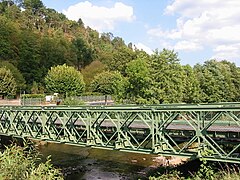Bailey bridges

Bailey bridge over the Meurthe River, France
|
|
| Ancestor | Truss bridge |
|---|---|
| Related | Callender-Hamilton bridge |
| Descendant | Mabey Logistic Support Bridge, Medium Girder Bridge |
| Carries | Pedestrians, Road vehicles, Rail Vehicles |
| Span range | Short |
| Material | Timber, steel |
| Movable | No |
| Design effort | Low |
| Falsework required | None |
The Bailey bridge is a type of portable, pre-fabricated, truss bridge. It was developed by the British during World War II for military use and saw extensive use by British, Canadian and US military engineering units.
A Bailey bridge had the advantages of requiring no special tools or heavy equipment to assemble. The wood and steel bridge elements were small and light enough to be carried in trucks and lifted into place by hand, without requiring the use of a crane. The bridges were strong enough to carry tanks. Bailey bridges continue to be extensively used in civil engineering construction projects and to provide temporary crossings for foot and vehicle traffic.
Donald Bailey was a civil servant in the British War Office who tinkered with model bridges as a hobby. He presented one such model to his chiefs, who saw some merit in the design. A team of Royal Engineer (RE) officers was assembled at the Military Engineering Experimental Establishment (MEXE), in Barrack Road Christchurch, Dorset, in 1941 and 1942. In the course of development, the bridge was tested in several formats, e.g., as a suspension bridge, and as a "stepped arch" bridge, as well as the flat truss bridge which became the standard. The prototype of this was used to span Mother Siller's Channel, which cuts through the nearby Stanpit Marshes, an area of marshland at the confluence of the River Avon and the River Stour. It remains there (50°43′31″N 1°45′44″W / 50.7252806°N 1.762155°W) as a functioning bridge. Bridges in the other formats were built, temporarily, to cross the Avon and Stour in the meadows nearby. After successful development and testing, the bridge was taken into service by the Corps of Royal Engineers and first used in North Africa in 1942. A number of bridges were available by 1944 for D-Day, when production was accelerated. The US also licensed the design and started rapid construction for their own use. Bailey was later knighted for his invention, which continues to be widely produced and used today.
...
Wikipedia
